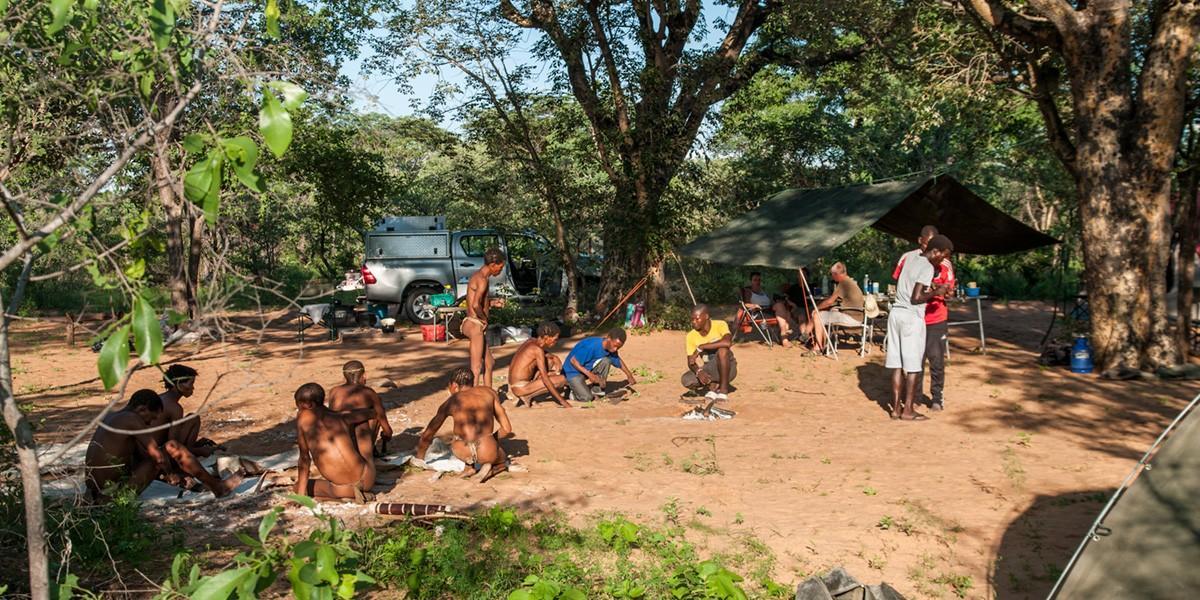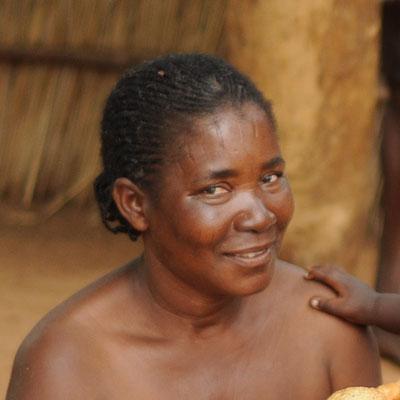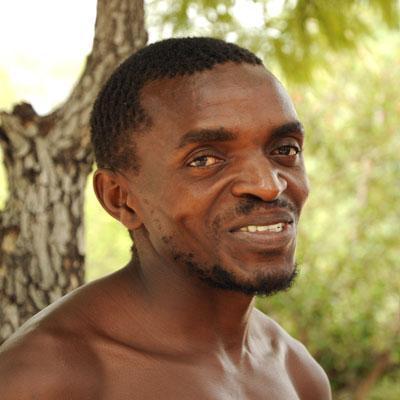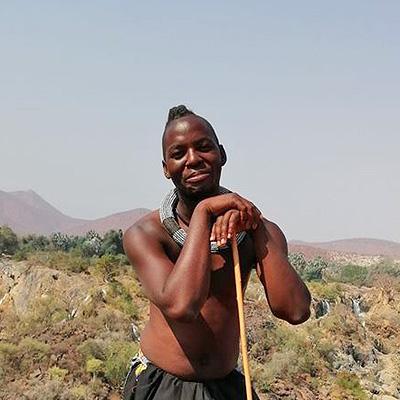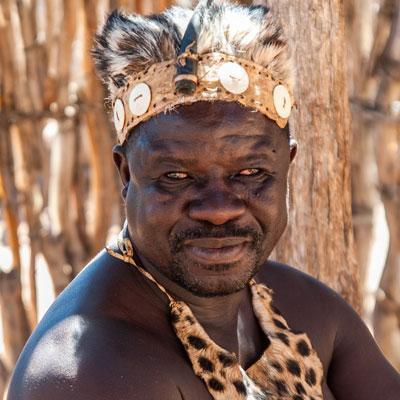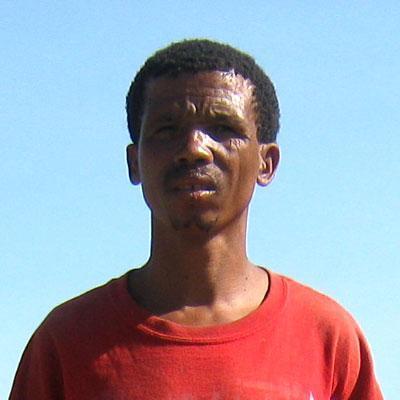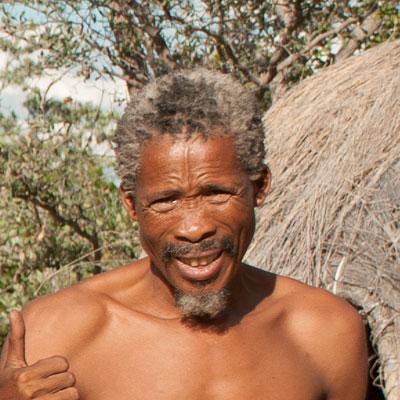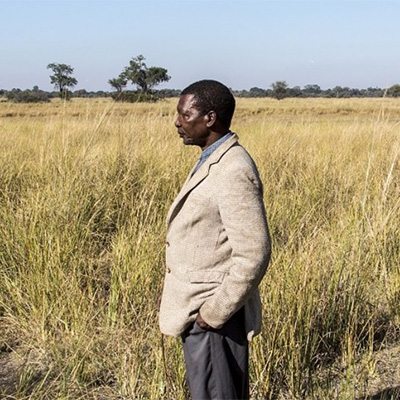Traditional workshop with the Khwe to encourage the establishment of a Living Museum close to Divundu
Since 2009 the LCFN has been trying to set up a project in the form of a living museum with the Khwe San in northern Namibia, unfortunately so far without success. Constantly changing project groups, little motivation and unrealistic demands by the Khwe group members, as well as some failed approaches by external development aid organizations made us think of the project as a failure.
We made a final attempt in January 2020. This was encouraged and financed by the Futouris association from Germany and the Namibian travel agency ATC, which have been supporting the traditional village of the Khwe since 2013. As a project sponsor in Germany, the German travel agency Gebeco is supporting the project.
The approach of LCFN was to go on a small workshop tour with some members of the newly formed project group of the Khwe and to visit two Living Museums, as well as to participate in a traditional workshop.
There were four main goals defined:
- To motivate the Khwe by visiting another museum
- To transfer the knowledge of how to establish a living museum (organization and administration, possible museum activities)
- To transfer traditional knowledge (production of clothing, tools and weapons, jewelry, etc.)
- To build trust between the project group and the project leader (what does the LCFN for the museum)
Report by project leader Sebastian Dürrschmidt
Background of the project tour: The Khwe have had a traditional village with a few straw huts since 2014. The village is being visited by ATC on their tours through Northern Namibia. The activities of tracking (bushwalk) and traditional dances with varying quality are offered to tourists at the cost of N$ 150 per person. Apart from ATC, nobody visits the village. There is a lack of infrastructure, motivation, activities and above all marketing.
I last visited the project in May 2017 and made many suggestions for improvement and tried to motivate the people. At the project meeting with the Khwe, I came up with the idea of organizing an intercultural workshop with the Ju / 'Hoansi, who have been running their Living Museum very successfully since 2004 and have an enormous amount of traditional knowledge. This suggestion was enthusiastically accepted by the Khwe. Due to a delay in funding from Gebeco, it took until early 2020 to organize this tour.
Day 1 – 13.01.2020
Long journey to Divundu with 900 km of tar road. I was accompanied by Herrmann from the German LCFN association.
Day 2 – 14.01.2020
On the second day I visited the project group in Mutc'iku at their project site. I originally wanted to visit the traditional village and take part in the offered activities, but at that time there were no huts or activities, which surprised me because I had had told the Khwe in advance several times.
Without the "Village Program" we went straight to the preliminary discussion. Khwe Manager Thaddeus Chedau, who had been the chairman of the Kyaramacan Association, which looks after the interests of the Khwe, reported on the developments and challenges in the project. Among other things, he said that the entire committee (external project coordinator, chairman, vice-chairman, understudy and treasurer) is no longer part of the group, which was not bad news for me at all, because - as I also told the project group - the important thing is not the Committee but the people who work in the Living Museum. And apart from that this committee was extremely oversized.
There are currently 10 people divided into two groups in the museum, i.e. five museum people per group, which is clearly not enough. Thaddeus continued to report that hardly any tourists come, that the activities were not implemented well, that the elephants broke the straw huts, that there was no water at Museum site and much more - all rather bad news.
I tried to motivate the group and explained the goals of the project trip and made some comments about the logistics. Among other things, we decided not to take six, but seven Khwe on tour as the 9-seater car rented by ATC made that possible. The next day we were supposed to start early at 7:00 a.m.
Day 3 – 15.01.2020
At 7:00 in the morning we picked up Thaddeus as well as three women and three men from the project group in Mutc'iku. Shopping in Rundu and a long day of driving, which was supposed to end in Grashoek at the Living Museum of the Ju / 'Hoansi were planned. Due to an incident with our rental car (the rim with tires had come loose, all bolts on the left side of the rear axis were defective and had to be replaced) our journey was delayed by four hours. Luckily no one was injured. We only drove to Roy’s Camp, about 100 km before Grashoek.
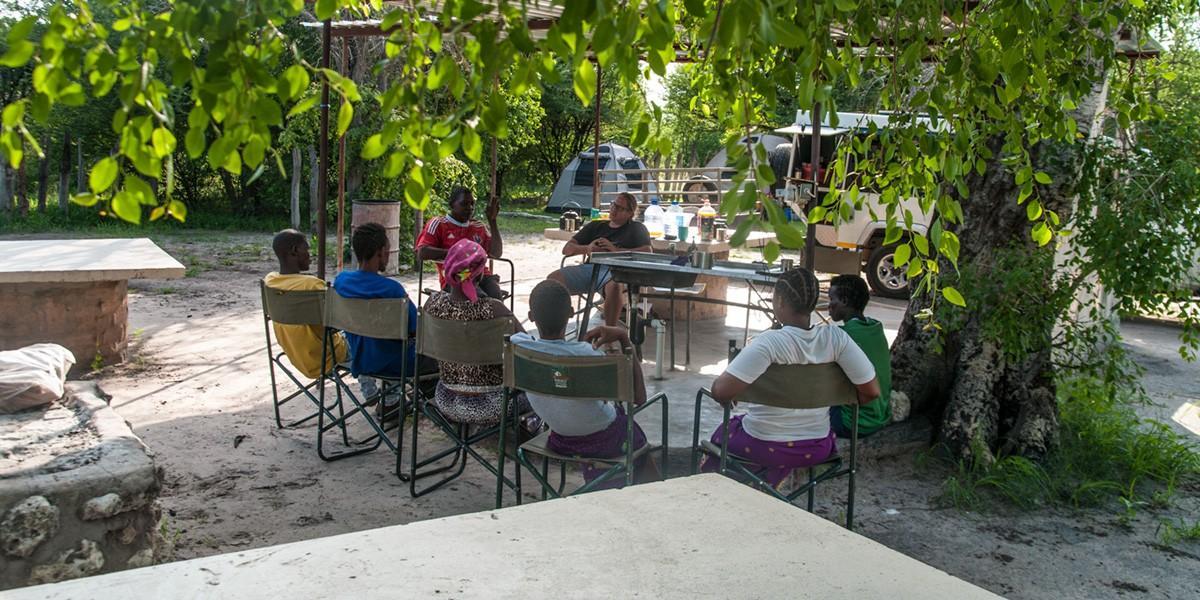
"Living Museum" concept meeting at Roy’s Camp
In the afternoon I again presented the concept of the Living Museum to everyone, focusing on the “Goals and Principles of the Living Museum”. There was an exciting round of discussion after which manager Thaddeus Chedau showed a photo collection he had brought from the Oswin-Köhler archive at the University of Frankfurt. The background was an invitation from Thaddeus to Germany, where a large part of the ethnological collection of Prof. Dr. Oswin Köhler is being stored. Koehler studied the culture and language of the Khwe from 1959 until his death in 1996 and left a huge collection of artifacts and documents in Cologne. There were pictures of tools and especially musical instruments that, as far as I know, did not exist in other San cultures and therefore appear to be unique for the Khwe.
After dinner we watched the one-hour film about "The Life of the Old Khwe", which anthropologist and Khwe researcher Gertrud Boden cut from old archive material from Oswin Köhler and which was later edited in cooperation with a committee of Khwe elders. It is about the village of Mutc'iku in 1962 and 1965. Among other things, hunting ceremonies, music pieces and a funeral are shown - It was very interesting.
Day 4 and 5 – 16.01.2020 & 17.01.2020
Very early the next morning we drove the remaining 100 km to Grashoek and first set up the camp.
Program in the Living Museum of the Ju / 'Hoansi
After setting up the camp, we took part in the approximately three-hour “Action Day” program. The aim of this program participation was to give the Khwe an insight into how other communities are designing the programs in their traditional villages. This should give a motivation boost and it should provide an idea of possible activities in the Khwe project.
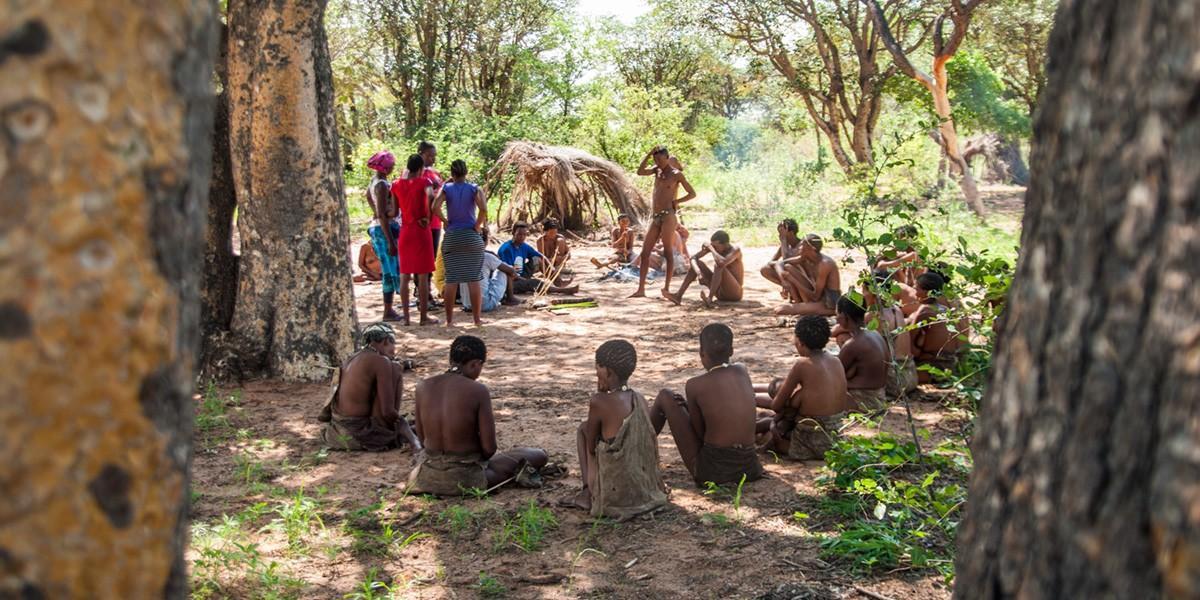
Program in the Living Museum of the Ju / 'Hoansi
None of the actors from Grashoek missed this, there were about 50 adults and a large number of children. The program was very captivating and interactive. The focus was on the following items:
- Traditional lighting of fires
- Explanation of quiver and arrows, arrow poison, traditional glue etc.
- Bushwalk and explanation of many native plants used by the San for Medicine, jewelry, food and cosmetics
- Production of bows and bowstrings from the wild raisin bush
- Production of threads and small ropes from Sansevieria
- Crafting jewelry from ostrich eggshells
- Traditional games
- Healing ceremony
In my opinion, the very interactive program, the friendly demeanor of the museum people and the huge, beautiful craft shop were an eye opener for the Khwe.
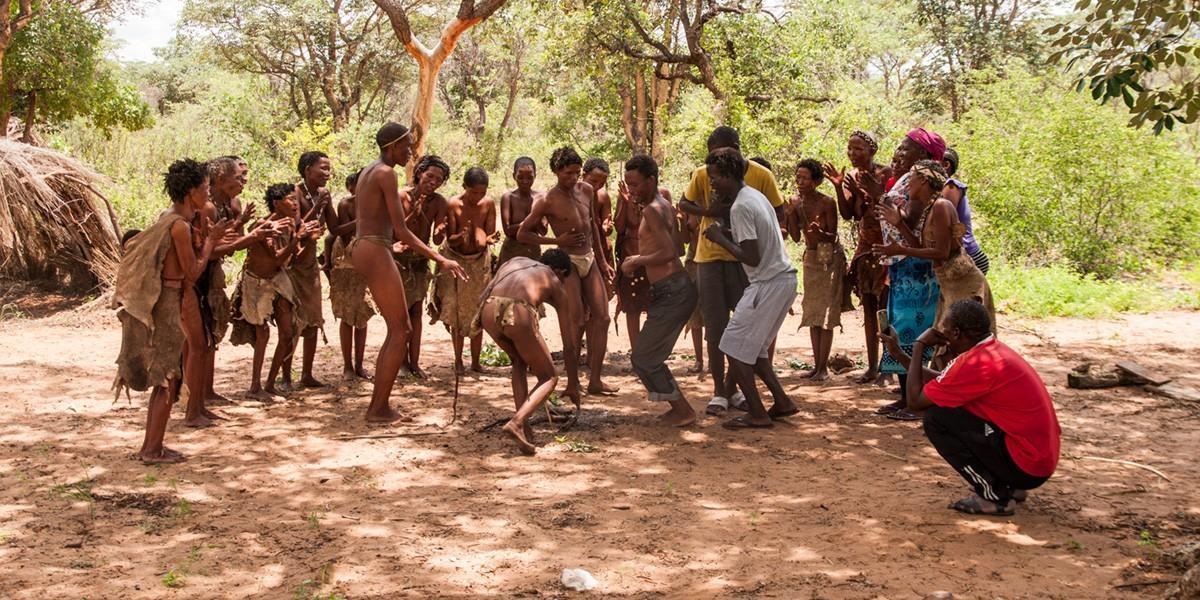
Khwe join the Ju / 'Hoansi group during the healing ritual
After the program, Antje Rahn from ATC arrived, she is responsible for coordinating with the Namibian tourism company and wanted to take part in the workshop.
Traditional workshop in the Ju / ‘Hoansi Living Museum
After a short lunch break, the workshop began, which was led by six traditional teachers and many other Ju / 'Hoansi-San from Grashoek.
The main goal of this workshop was to show the Khwe the specific techniques how traditional things like clothes, weapons, tools and jewelry can be made in an interactive way. This was done with the awareness of the big differences between the culture of the Khwe and the culture of the the Ju / ‘Hoansi. For example, the two groups speak a completely different language (which sounds completely identical to outsiders) and do not understand each other. Other parts of the visible and invisible culture are also very different, such as hut construction, musical instruments, weapons, tools, blacksmithing. Nevertheless, through this intercultural knowledge transfer on the part of the Khwe, many important traditional techniques could be learned with which they can craft culture-specific things.
Activities specific to women
Jewelry production: The three women of the Khwe made jewelry for the next two days from ostrich eggshells, which we had brought from Windhoek, seeds and wooden beads. They also learned about various dyeing techniques for ostrich eggshells as well as usage for wooden beads for decorative purposes.
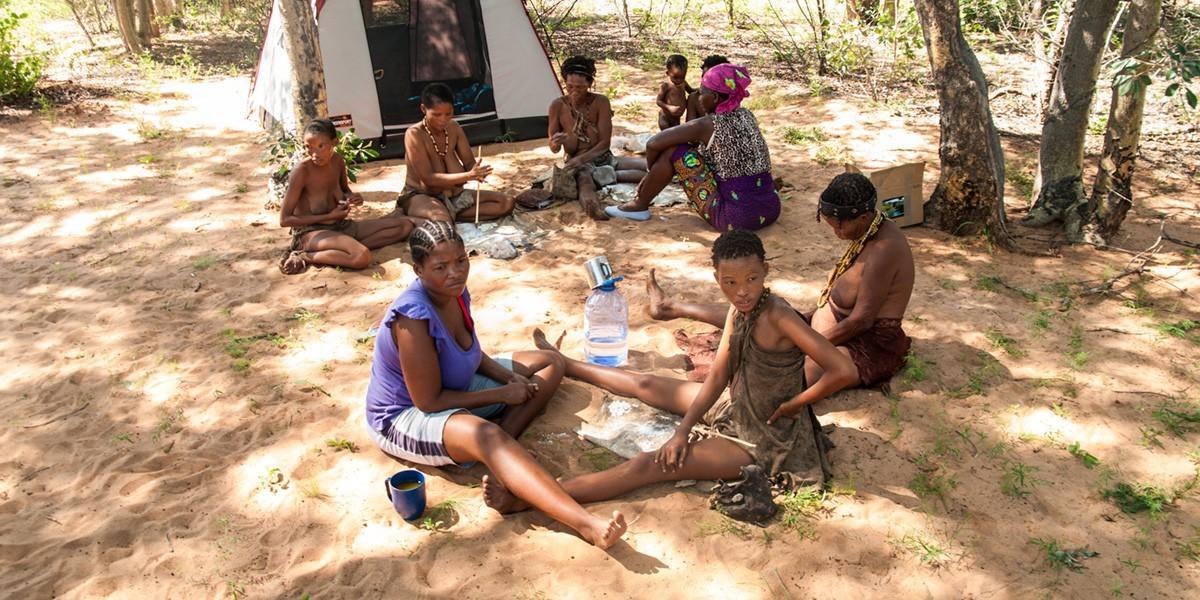
Jewelry production
Activities specific to men
Fur processing: After removing the hair and tendon and fat residues from our Impala skins, they tanned the leather using the wild onion root, which was then cut specifically for women and men.
Quiver production: Quivers were made from the root of the False Acacia by "baking" them in the sandy soil and closing them at the ends with fur.
Bow carving and string making: Sansevieria plants were made into cords and thin ropes. Bows were built that were carved in larger sizes for the Khwe.
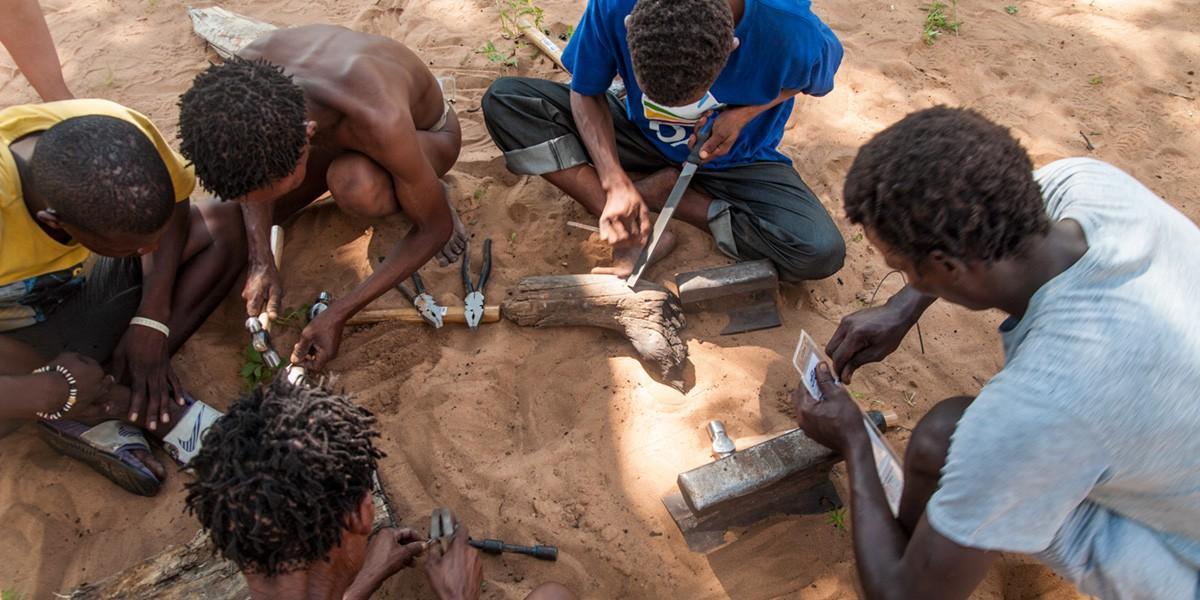
Blacksmithing
Blacksmithing: A major part of the workshop was blacksmithing. Arrowheads (see difference between Ju / 'Hoansi and Khwe arrowheads in the image below), spearheads and knife blades were made. Small axes, the so-called Chop-Chops, were also produced.
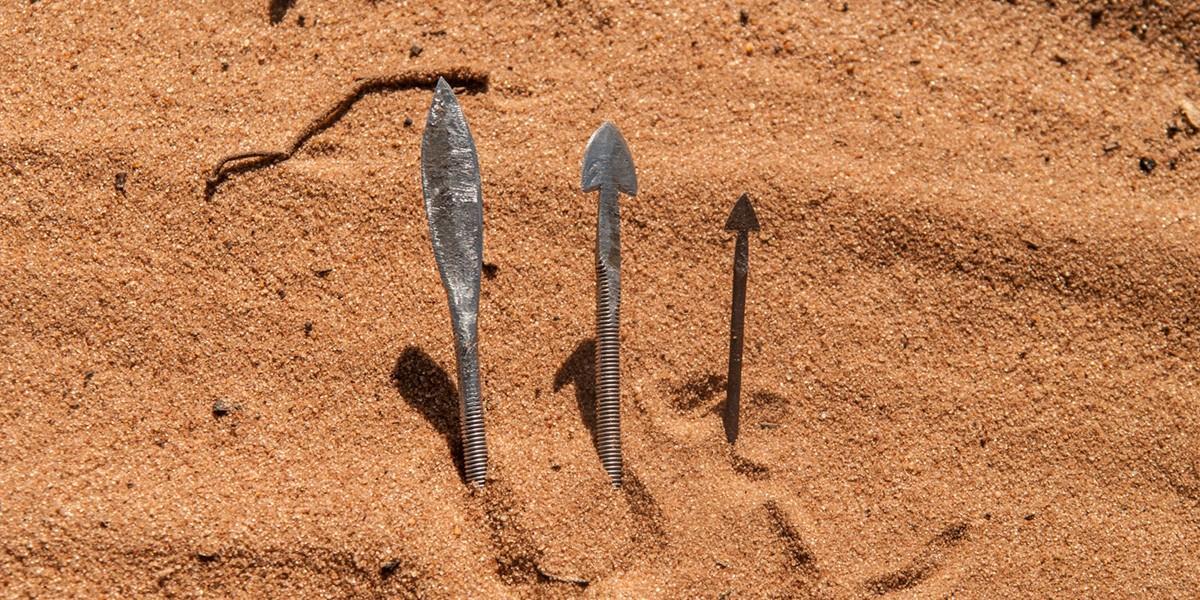
Two Khwe arrowheads on the left, one Ju/Hoansi on the right
All in all, it was two very exciting and busy days. The two groups worked every day with lunch breaks from 7:00 am until late in the evening.
Day 6 – 18.01.2020
On the third day of the workshop, traditional clothing was completed by noon and the rest of the things were finalized. In the end there was a nice group photo and a warm goodbye between Ju / ’Hoansi and Khwe.
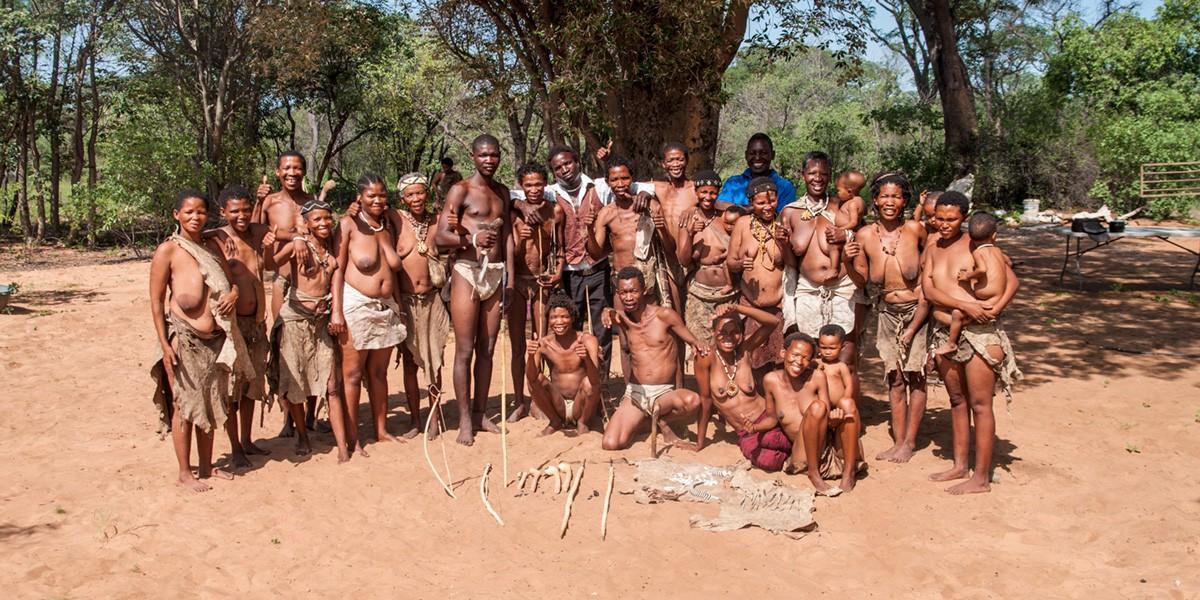
Group photo
We drove in the direction of Rundu, set up the camp at the Samsitu campsite and discussed the do’s and don’ts of the Living Museum in the afternoon. I also started a question and answer session with all the Khwe about what they thought about the trip. They seemed very enthusiastic and motivated and thankful for the opportunity to take part in this workshop and in the museum programs.
Finally, I gave some specific tips on how to further develop their museum and asked them to sit down in the late afternoon and work out a program for their Living Museum. After viewing these program sketches, I found that they were too close to the activities of the Ju/'Hoansi Living Museum, the uniqueness and individuality of the Khwe culture was missing. This was addressed and I mentioned that they weren’t supposed to create an exact copy of the Ju/'Hoansi activities.
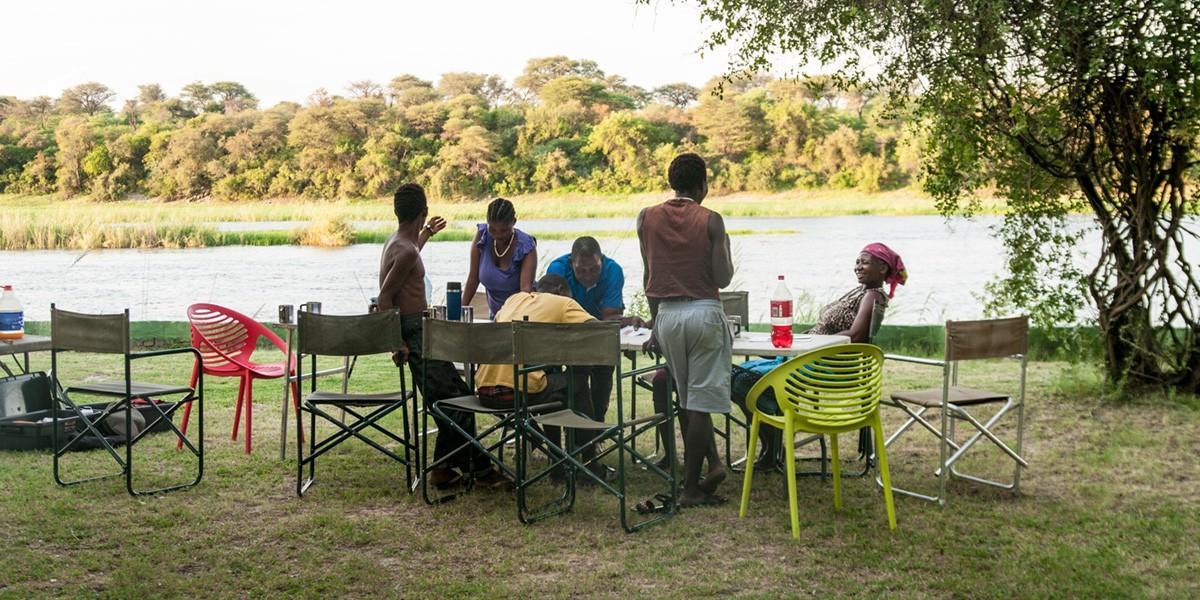
Khwe program design workshop at the Okavango river bank
Day 7 – 19.01.2020
Before I drove the Khwe back to Mutc'iku, we visited the Mbunza Living Museum on Lake Samsitu (which unfortunately is still dried out at the moment). This project, which is very different from the Ju/'Hoansi Museum, has a large traditional village and very different activities, gave the Khwe more food for thought in a slightly different direction regarding the possible activities in their own museum. Activities such as forging, traditional games were particularly well received.
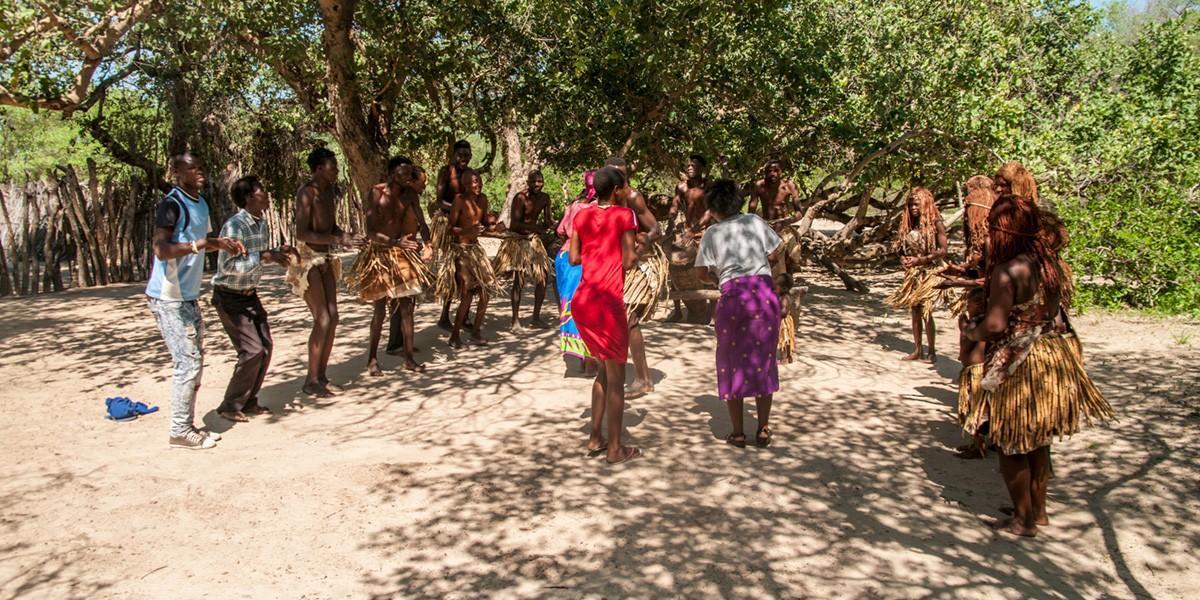
In the Mbunza Living Museum
Day 8 – 20.01.2020
Long return trip from Divundu to Windhoek
Conclusion of the workshop tour with the Khwe
The four goals of the traditional workshop were achieved:
- Motivation by visiting the museum
The visit to the two museums showed the Khwe what possibilities there are for the traditional representation within the Living Museums. The interactivity and good performance of the players of the Ju/'Hoansi and Mbunza made it possible to clarify the concept in a practical way and to include the Khwe in the process. I am sure that after the workshop, the Khwe can imagine much better how they can now make their own project more interactive and diverse.
- Knowledge transfer botu Living Museum (organization and administration, possible activities)
Through discussions and descriptions of the concept of the Living Museums during the days of the trip, the Khwe could certainly get a greater understanding of the concept in general, but also of how a living museum can be organized and managed. This will be intensified in further meetings with the Khwe.
- Traditional knowledge transfer (production of traditional clothing, tools and weapons, jewelry etc.)
The actual traditional Khwe workshop at the Ju / 'Hoansi was an enormous success. Many things have already been crafted and can be used in the Khwe Living Museum. Above all, traditional techniques were taught in many areas, always with the understanding that the traditional Khwe culture differs from the culture of the Ju/'Hoansi. Back in Windhoek, two scientific experts were contacted, who can later deal with the project from an anthropological (Gertrud Boden) and linguistic (Anne-Marie Fehn) perspective. They have kindly agreed to provide their support.
- Building trust between the project group and the leader and the question of which areas the LCFN covers
The tour was the first to establish a closer cooperation between the LCFN and a motivated project group. In the past this was prevented by the project leaders on Khwe side, who were constantly changing. In discussions, the task of the LCFN was clarified several times and its expectations of a Khwe Living Museum were presented. By visiting the Living Museums, the Khwe saw various marketing aspects directly, for example the large street signs, reception signs, logos, programs and much more things provided by the LCFN. It was decided to create a logo for the Khwe museum with an elephant and San tracker. I will present this logo at the next meeting.
When you subscribe to the blog, we will send you an e-mail when there are new updates on the site so you wouldn't miss them.



